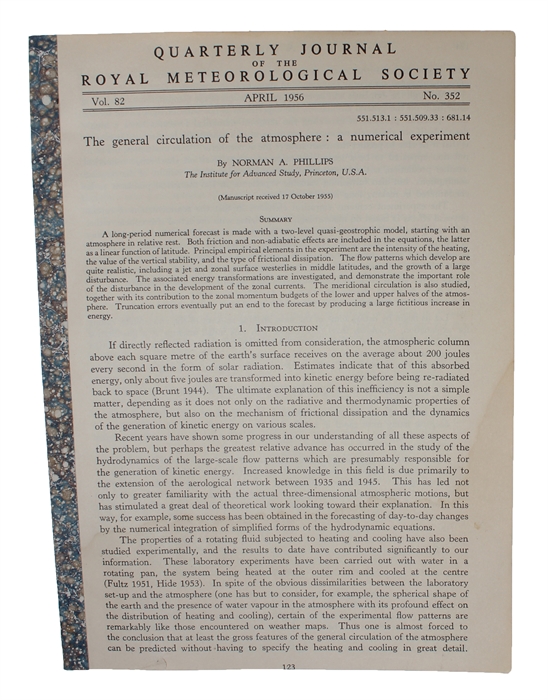THE FIRST SUCCESFUL CLIMATE MODEL
PHILLIPS, NORMAN A.
The general circulation of the atmosphere: a numerical experiment. [Extracted from: Quarterly Journal of the Royal Meteorological Society Vol. 82 No. 352, April 1956].
(London, Royal Meteorological Society, 1956).
8vo. Extracted and with a nice marbled paper-backstrip (kind of representing the elements). Damp-staining to lower part of leaves. Pp. 123-164. Illustrated.
First printing of Phillips' seminal paper, in which he presents for the first time his mathematical model that could realistically depict monthly and seasonal patterns in the troposphere. This became became the first successful general circulation model of climate (GCM). "Numerical models (General Circulation Models or GCMs), representing physical processes in the atmosphere, ocean, cryosphere and land surface, are the most advanced tools currently available for simulating the response of the global climate system to increasing greenhouse gas concentrations. While simpler models have also been used to provide globally - or regionally-averaged estimates of the climate response, only GCMs, possibly in conjunction with nested regional models, have the potential to provide geographically and physically consistent estimates of regional climate change which are required in impact analysis... In 1956, Norman Phillips developed a mathematical model that could realistically depict monthly and seasonal patterns in the troposphere, thus revolutionizing weather and climate change predition. It became the first successful climate model. Following Phillips' work, several groups began working to create GCMs that are now essential to predict climate change. "Steady improvements to short-range NWP accrued during the early 1950s, in large part due to more realistic models that accounted for energy conversion in extratropical cyclones. Encouraged by the success of these forecasts, IAS team member Norman Phillips began to contemplate longer-range prediction using the IAS computer. His work took the form of a numerical simulation of the atmosphere's general circu lation for a period of 1 month. The work was completed in 1955 and Phillips communicated the results to von Neumann, who immediately recognized their significance. Von Neumann hastily arranged a conference in October 1955, Application of Numerical Integration Techniques to the Problem of the General Circulation, held at Princeton University. In his opening statement at the conference, von Neumann said I should like to make a few general remarks concerning the problem of forecasting climate fluctuations and the various aspects of the general circulation that cause such fluctuations. Specifically, I wish to point out that the hydro-dynamical and computational efforts which have been made in connection with the problem of short-range forecasting serve as a natural introduction to an effort in this direction . . . With this philosophy in mind, we held our first meeting nine years ago at the Institute for Advanced Study to discuss the problem of short-range weather prediction. Since that time, a great deal of progress has been made in the subject, and we feel that we are now prepared to enter into the problem of forecasting the longer period fluctuations of the general circulation. (von Neumann 1955, 9-10) Following this conference, which highlighted his numerical experiment, Phillips entered the research into competition for the first Napier Shaw Memorial Prize, a prize honoring England's venerated leader of meteorology, Sir Napier Shaw (1854-1945), on the occasion of the centenary of his birth (the competition was announced in April 1954). The subject for the first competition was "the energetics of the atmosphere." On 20 June 1956, "the adjudicators recommended that the prize be given to Norman A. Phillips of the Institute of Advanced Study, Princeton, U.S.A. for his essay 'The general circulation of the atmosphere: a numerical experiment,' which had been published in the Quarterly Journal [of the Royal Meteorological Society] (82, p. 1230) [April 1956] ..." (Quarterly Journal of the Royal Meteorological Society 1956b)" (Lewis: Clarifying the Dynamics of the General Circulation: Phillips's 1956 Experiment).
GCMs depict the climate using a three dimensional grid over the globe, typically having a horizontal resolution of between 250 and 600 km, 10 to 20 vertical layers in the atmosphere and sometimes as many as 30 layers in the oceans." (IPCC - International Panel on Climate Change).
Order-nr.: 59954


![The general circulation of the atmosphere: a numerical experiment. [Extracted from: Quarterly Journal of the Royal Meteorological Society Vol. 82 No. 352, April 1956].](/images/product/59954b.jpg)